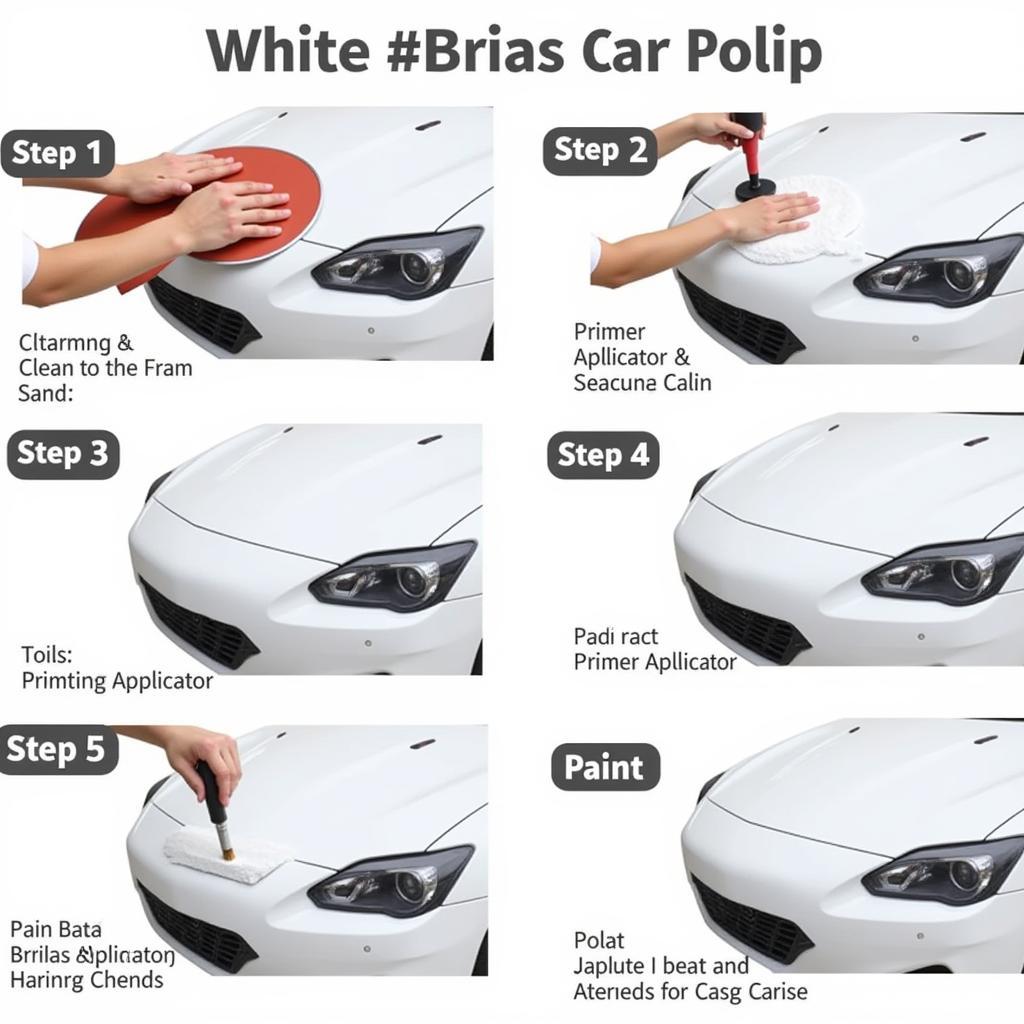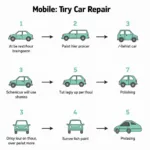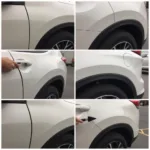White car paint, while classic and elegant, is notoriously prone to showing scratches, chips, and other blemishes. Knowing how to effectively perform a white car paint repair can save you significant money and maintain your vehicle’s pristine appearance. This guide covers everything from minor touch-ups to more extensive repairs, offering valuable insights for both DIY enthusiasts and those seeking professional help. We’ll explore the nuances of working with white paint, the different types of damage, and the best techniques for achieving a seamless finish.
Repairing white car paint can seem daunting, but with the right knowledge and tools, it’s achievable. Whether you’re dealing with a small rock chip or a larger scuff, understanding the specific requirements of white paint is crucial. This involves choosing the correct paint type and application method for a flawless repair. Matching the exact shade of white can be tricky, so we’ll delve into that process as well. The type of damage also dictates the repair process. Superficial scratches might only require a polishing compound, while deeper damage might necessitate primer and several coats of paint.
Understanding White Car Paint and Repair Options
White car paint comes in various shades and finishes, from solid white to pearl white and metallic white. Each requires a slightly different approach to repair. Understanding your car’s specific paint code is paramount for a perfect match. For instance, a pearl white car paint repair requires specialized techniques compared to a solid white repair. The repair process generally involves cleaning the area, sanding if necessary, applying primer, painting, and finally, clear coating and polishing for a professional finish.
For minor scratches and swirl marks, a polishing compound might be sufficient. Deeper scratches and chips will require touch-up paint, often available in pens or small bottles. For larger areas of damage, spray cans or professional spray guns are recommended. When dealing with more significant damage, like dents or deep scratches, professional bodywork might be necessary before painting. This could include filling dents, sanding, and priming the area to ensure a smooth surface for paint application.
DIY White Car Paint Repair: Tips and Tricks
If you’re tackling the repair yourself, meticulous preparation is key. Thoroughly clean the damaged area with soap and water, followed by a degreaser. This ensures the paint adheres properly. For deeper scratches, sanding with progressively finer grits of sandpaper is crucial to create a smooth surface. Applying primer before painting is highly recommended, especially for chips and scratches that have penetrated the existing paint layer. This helps the new paint adhere and prevents rust formation.
When applying the paint, multiple thin coats are better than one thick coat. This allows each layer to dry properly and prevents runs or drips. Patience is essential here. Allow each coat to dry completely before applying the next. For small touch-ups, a white paint car chip repair kit can be very effective. After the final coat, apply a clear coat to protect the paint and provide a glossy finish. Finally, polishing can blend the repaired area seamlessly with the surrounding paintwork, achieving a professional-looking result.
“The most common mistake people make is rushing the process,” says automotive expert, John Miller. “Take your time, prepare the surface properly, and apply thin coats of paint. This will give you the best possible results.”
When to Seek Professional Help
While minor scratches can often be addressed with DIY methods, more extensive damage or complex paint types might require professional intervention. A vw candy white car paint repair, for example, often requires specialized knowledge and equipment. If you’re unsure about your abilities or the extent of the damage, it’s always best to consult a professional. They have the expertise and tools to handle complex repairs, ensuring a flawless finish.
“For intricate paint jobs or significant damage, seeking professional help is the safest bet,” advises Sarah Chen, a seasoned auto body technician. “They have the experience and equipment to handle complex repairs, ensuring a factory-like finish.” Professional repair shops, like those specializing in car repair and painting white center seattle, can accurately match your car’s paint code and perform a seamless repair, even for challenging repairs like pearl or metallic finishes. A vw candy white car paint repair kit can be useful for minor touch-ups, but professional assistance is often recommended for larger areas or more complex damage.
In conclusion, maintaining the pristine look of your white car requires attention to detail and the right approach to repairs. Whether you choose DIY methods or professional help, understanding the nuances of white car paint repair will ensure a successful outcome. Remember, patience and careful preparation are essential for achieving a flawless and long-lasting finish.
FAQ
- How do I find my car’s paint code?
- What is the best type of paint to use for white car paint repair?
- Can I repair a deep scratch myself?
- How long does it take for touch-up paint to dry?
- How can I prevent future scratches and chips?
- What’s the difference between pearl white and metallic white?
- How much does professional white car paint repair cost?
Need help with your white car paint repair? Contact us via WhatsApp: +1(641)206-8880 or Email: [email protected]. Our 24/7 customer support team is here to assist you.



